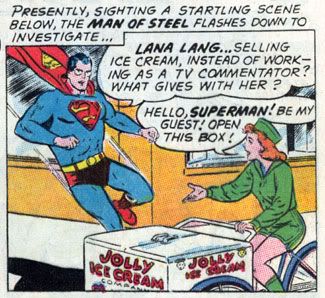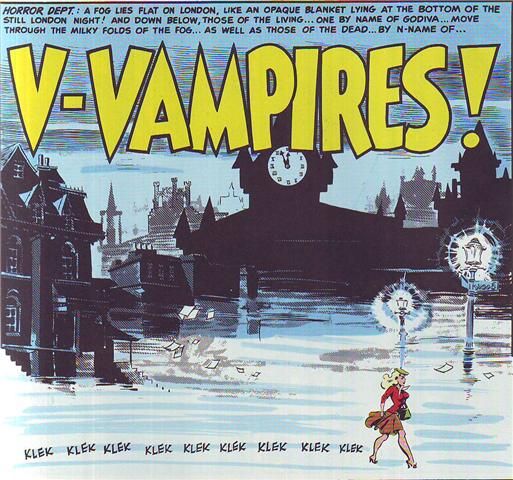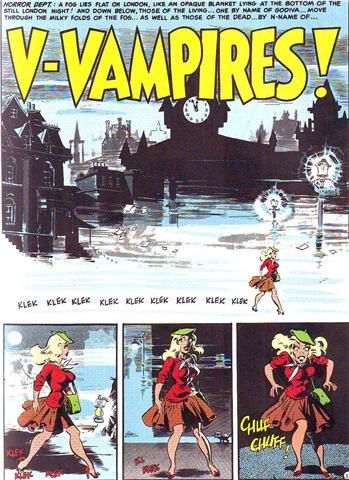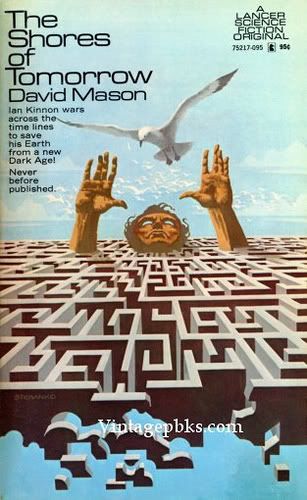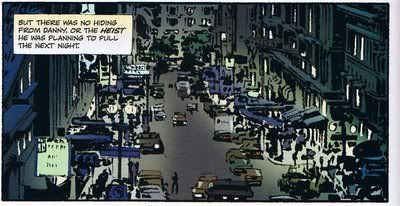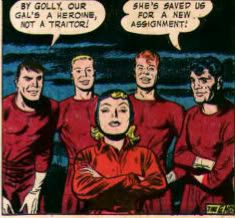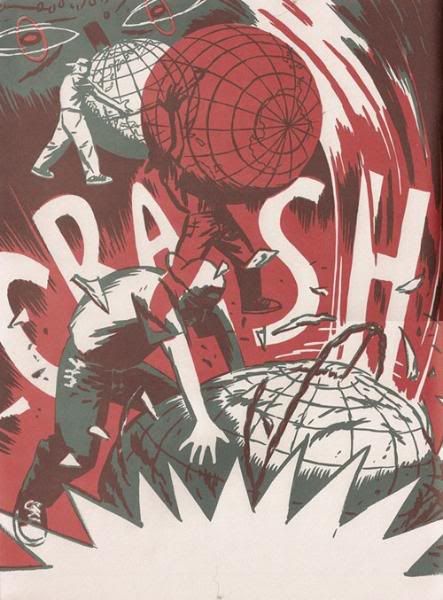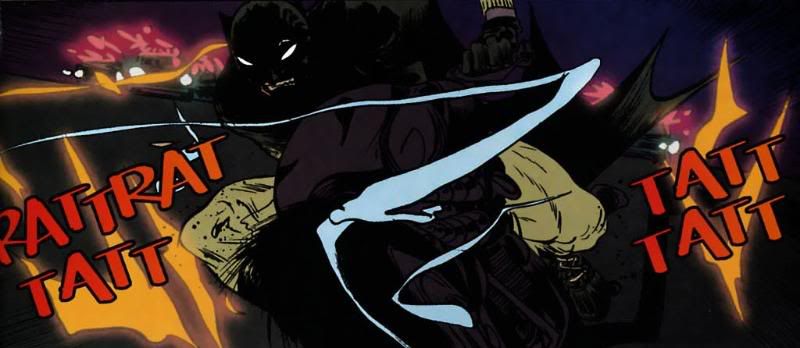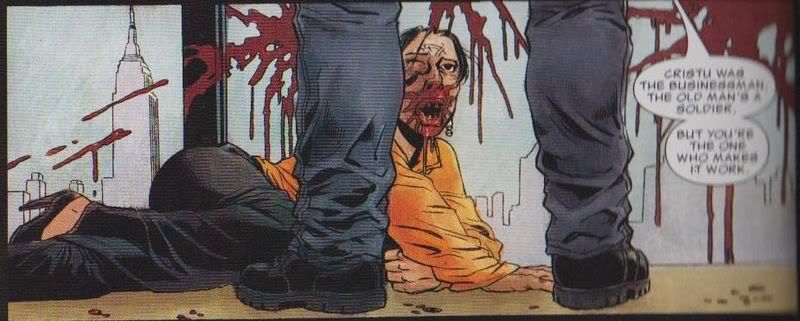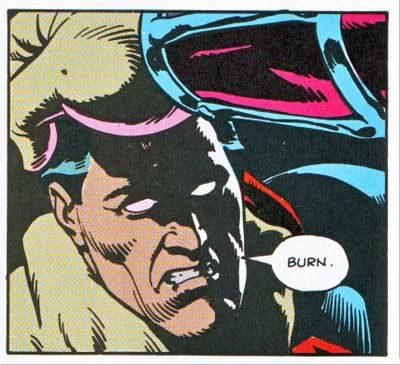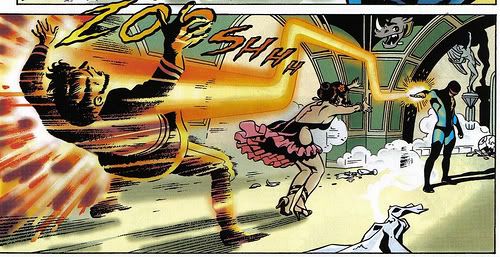So, we're gonna play "Guess Where this (Slightly Edited) Image is From."
Answer Waaaaayyyyy down at the bottom.
Klek Klek Klek Klek Klek Klek Klek.
Heh heh.
So, folks, welcome to PANEL MADNESS WEEK (Because we don't talk enough about the art) a ten part jaunt round the comics blogsphere where everyone picks one ONE panel, or book cover, or any image that is a small part of a larger work, and talks about it. The whole she-bang was organized by my good virtual buddy Plok of Trout In The Milk fame, and he'll report to work monday with the final piece of the puzzle.
Before we get into it, a word of w-a-r-n-i-n-g. This is gonna get nerdy, and nerdy in a "Obsessively interested in graphic design and the philosophy of information" way. What's more, it's gonna deal with stuff that you (seasoned and cynical comic reader that you are) already know. Anyway, this here post is enough different from most CSBG content as to merit a disclaimer.
So.
One panel.
One panel by itself isn't really a functional thing, so-ta-speak. It's not doing what a comic panel is supposed to do; IE pleasure the eye long enough to impart 1/145 of a story's worth of information. (Or 1/24th in an Ed McGuiness Hulk comic. Whatevs.)
In a lot of ways one, panel is like an amputated limb, all cut off from the main story and flopping and dripping and spurting. In OTHER ways, though... There's a lot of interesting stuff going down here.
So what IS an individual panel?
Here's five answers. This panel is a...
Story Unto Itself: Most panels imply - If very rarely show - enough action that they can serve as a small story unto themselves, complete with a beginning and an end. The story here is "A woman is walking briskly through a city at night. She's alone." The story begins at one edge of the page and ends at the other.
Unit of TIme: Or "How long does the story take?" While a single panel implies only the briefest sliver of time, there's usually (again) implied action before and after the stuff we see on the page. This panel, ferinstance
Takes around 30 seconds, as Superman swoops down, says his piece, and Lana replies.
OUR panel probably takes around 15 seconds, or 9 klecks worth. Often the panels that take the most time are the most important (and biggest) on the page.
Abstract Composition: We all know Whistler's Mother right?
Except that it's not. Whistler was always adamant about this. "It's not my mother! It's just paint splattered on a canvas!' In fact, The actual name of the above painting is disappointingly un-poetic: "Arrangement In Grey and Black."
And comics panels are not Whistler's Mother either. OUR panel is lines and colors on paper that we interpret as buildings and a human figure, but that's because we're trained in a language of visual abstraction. All it really is... is lines on paper and colors. And what-the-artist-is-DOING with lines on paper (other than, y'know, drawing stuff) can be important, too. So if we actively ignore Whistler's Mother, and focus on the lines and colors, what do we see?
Black and white. Lots of blacks and whites fighting it out on top, with a BIG chunka black in the middle - both horizontally and vertically. Noting but negative space at the bottom, which makes the shocking red in the lower right really stand out.
What else? Lots of sharp, pointy shapes. Everything here looks like it has an edge on it. Even the street lamps are more angular than rounded. The only "safe" place in the painting is the female figure, but even her scarf looks like a knife blade... And there's a reason for this, it's setting the
Mood Indicator/Foreshadower: Ominous, right? The reason there's a lot of deep, deep blacks and uncomfortable contrasts and sharp, pointy angles is that that stuff looks FREAKY. In fact, y'all probably won't be too surprised when I pull out the full panel....
A vampire story. That's hardly a surprise. The story has a woman, totally alone, at night, in an urban setting. We've all seen enough movies to tie THAT particular sequence of events to a particular genre, and it ain't romantic comedy. And, on top of that, the artist is going out of his way to draw off-kilter, pointy, dangerous looking imagery.
Some of you might have even put the city as London, which would, in 90% of horror films, mean either Jack the Ripper or Dracula.
But on the other hand... the letters... bright yellow? The stutter? And, come to think, the klek...klek..klek sound effects are more than a little tongue in cheek as well. Somethings not right here.
One Element of the Overall Page:
Now we have MORE panels, each of them a story, a unit of time, an abstract composition, a mood setter, and an element of the overall page. OUR panel is an establishing shot, setting the scene before we get a better look at the woman below. Thinking in Whistler's Mother terms, it's worth noting that the bright red, (and the immediately recognizable human form wearing it) are probably going to be the first thing we look at before we get to the top panel which is more abstract, less immediately eye-catching, and full of boring words.
I don't want to spend too much time here, but one more cool thing: In the first panel the woman is walking into the light. In the bottom panels, she's proceeding on into the dark.
The Panel as Cultural History: New game!
imagine that it's three hundred years in the future, comics have long since died out and all entertainment media is distributed via telep-o-vision.
You are seeing a comic, this comic, for the first time.
What can you tell me about the bizzare, alien culture that produced this image? Specifically, what can you tell me about (A) the societal role of women and (B) their media's approach to sexuality?
What? I'm not going to answer for ya. That's what comments are for.
Art always, always mirrors/is defined by/defines the culture it's part of. Even one single panel of one comic book.
The Panel as Comics History:
And there you have it. It's a story from back when venerable ol' MAD was an EC comic book, 57 years ago. This particular panel is drawn by the great Wally Wood.
This image is reprinted, and has been substantially altered - re-colored and re-printed on larger and better quality paper - so many of the technological cues that might tell us when this comic was originally published are absent...
But I bet there's still plenty of you who recognize this page, OR the style of the artist, Or the content, level of detail and general tone of the image with sufficient acuity to be able to tell me WHEN this comic was published, and the company that published it. Plok actually knew the artist, series title, and issue number. And being part of a specific story by a specific artist in a specific school in a specific time of history in a specific medium in (again) a specific culture - All of those things make it a little chunk of history.
So this panel is a teeny part of the whole "V-Vampires!" narrative, and it's a teeny part of a lot of other stories as well. The "How the absurdist satire in Mad shaped the anti-authoritarian culture of the '60s" The "How Harvey Kurtzman influenced Spiegelman and Crumb and kind of created alternative comics" story. The "Why the hell did Wally Wood kill himself?" story.
And the ACTUAL story, which we've been so steadfastly ignoring?
(Scanned from the MAD Archives vol. 1. Written and edited by Harvey Kurtzman.)
Gets pretty silly. I'm a huge fan of the art in EC Comics. The writing? Not so much. But even when the stories ain't up to snuff I've got 1,116 individual panels to look at.
Panel Madness Recap: (Click on the panels to be transported.)
Day 1
Day 2
Day 3
Day 4
Day 5
Day 6
Day 7
Day 7 anna Half
And we'll be heading back to Plok one more time for Day 9.


